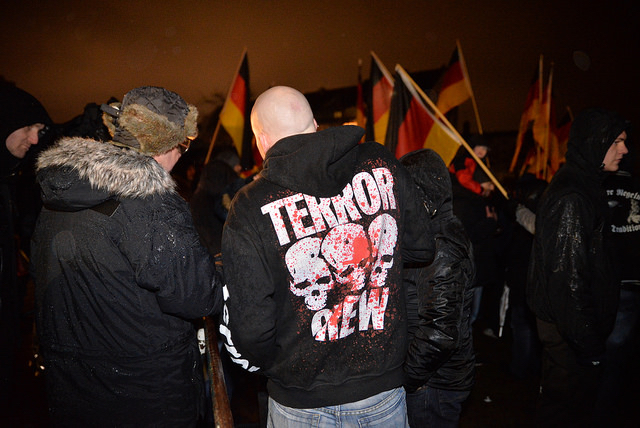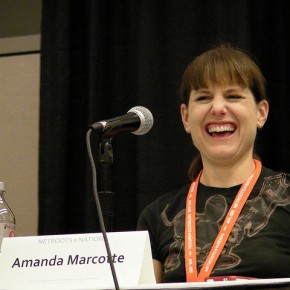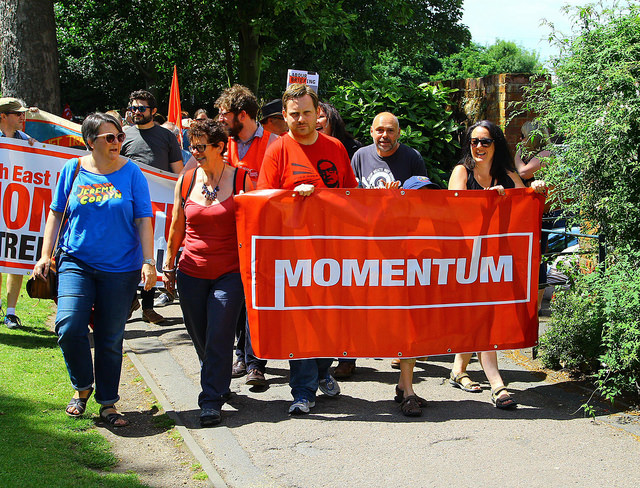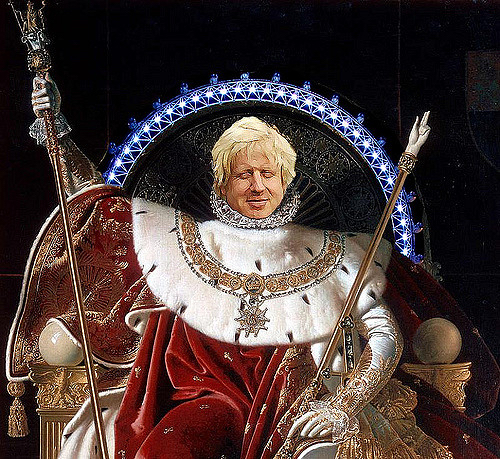The right is on the rise in Germany. On October 19th, 20,000 people gathered in Dresden under the banner of the far-right, anti-immigration group “PEGIDA”. They were marking a special occasion: Only one year earlier, several dozen self-proclaimed “patriots” had first met to protest the coming “Islamization of the Occident.”
The weekly demonstrations soon began to attract growing numbers of people, peaking at almost 30,000 last January, and spawning many similar movements all over the country. As the organization met widespread resistance, however, and was further weakened by infighting, the numbers began to decline. Increasingly, it was only a few thousand of often hardened neo-Nazis who still bothered to show up – and young soccer hooligans looking for a fight with ANTIFA.
Many expected PEGIDA to run the course of many similar right-wing movement-phenomena before: Initially attracting many people with its populist message, but soon – due to growing anti-fascist resistance and unflattering exposition in the media – becoming isolated. In fact, fulfilling the prophecy, the movement became quickly integrated with established neo-fascist groups, and grew ever more unhinged in its rage and frustration. As the more moderate supporters stayed away, and only the extremists remained, it was expected that at least this particular brand of reaction had been too damaged, and would soon run its course.
A similar fate, in fact, was expected for the right-wing party Alternative for Germany (AfD), which was founded only two years ago, but already holds seats in many regional parliaments. From the very beginning, the party has had problems presenting a respectable face to the outside world and keep its more radical factions, based mainly in the East of Germany, in check. This summer, however, the tensions escalated at a turbulent party congress, and the moderate wing was purged. The party’s founder, neoliberal economics professor Bernd Lucke, who had until then been its reasonable, soft-talking, and well-educated public face, resigned under the vengeful jeers and boos from his bloodthirsty base, which took cruel pleasure in punishing him for the many times he had publicly tried to disown his party’s more radical factions. Interestingly, a similar development took place at the same time in Germany’s Friedrich von Hayek Society, which was founded in 1998 as a vehicle for the promotion of neoliberalism. Originally, it had been a very civilized, elite organization, bringing together conservative-liberal professors, businessmen, journalists, and members of the comparatively progressive liberal party FDP. In recent years, however, it was overtaken by the anti-establishment right: hardcore-libertarians, gold bugs, and anti-socialist reactionaries of all stripes. A congress in June almost erupted in screaming matches, and almost half of its members left the organization – the moderate half.
What does it mean, then, that this radicalization of the right has not isolated it at all? Once again, tens of thousands in Dresden and elsewhere in the country are protesting against immigration and refugees, and calling openly for the fall of the government. The AfD, aligning itself with these protest movements, is polling again at 8%. Violence is on the rise as well. Almost daily, somewhere in the country, facilities which housing refugees are set on fire. Just recently, a social democratic mayoral candidate in Cologne, who was active in pro-refugee politics, was stabbed in the throat by a neo-Nazi, and only barely survived. Even in small towns, protests against planned housing for refugees are able to draw large crowds and often erupt in violent clashes with the police. All over the country, the right-wing resistance is organizing and growing. The number of refugees entering the country since the summer, while certainly not the reason for this resurgence of the right, serves as a catalyst, activating long-dormant powerful trends, and rapidly politicizing the silent anti-immigrant majority. Right-wing activists in Germany and Austria are in an apocalyptic mood. In their fevered imagination, the “case of emergency” they have so long predicted has finally arrived, and the eradication of German white identity and the collapse of multicultural society are nigh. They call it Vorbürgerkrieg, or “Pre-Civil-War”.
At the same time, Angela Merkel is facing a growing internal insurrection from her own party’s right wing (and particularly from the Bavarian conservative sister party, the Christian Social Union (CSU). Her proverbially stable and calm government, which for ten years faced almost no effective opposition, is for the first time beginning to look shaky. Many cannot forgive her for taking a public stance in favor of humane treatment of refugees, and as the local administrative infrastructure is struggling to keep up with housing the arriving people, the blame for the many unavoidable problems are laid at her feet.
At demonstrations all over the country, the new reactionary movements are calling for Merkel’s resignation. To right-wing extemists, it does not matter that she is actually working hard to stem the flow of refugees. They don’t care that she is right now shamelessly haggling with the autocratic Turkish government over what she has to offer them to seal off the transit route through the Aegean. They don’t care that during the summer, while Merkel was still being congratulated for her liberal stance on refugees, her government passed a severely restrictive reform of the asylum law, radically reducing the chances of refugees, especially Roma from Kosovo and other Balkan states. (This restriction of the asylum law met little resistance, by the way, and was supported by the Greens, which had the votes to kill it.) They don’t care that she is now even contemplating sending back Afghans to their war-torn homeland. They don’t care that she is working with the EU to seal off our outside borders, that she is working to quicken the pace of deportations. To the far-right, all this does not matter. The only thing they see is that Merkel refuses to give in publicly to the fear- and hate-mongering rhetoric of the fringe right, and even of many of her colleagues. For this, she can’t be forgiven. Three weeks ago, a demonstrator in Dresden carried a gallows with her name on it.

So what is at the root of all this hate? It’s easy to jump to facile conclusions, to explain it as a spontaneous reaction to the influx of refugees, or to find some explanation in the cultural genome of “backwards” East Germans. There are in fact two dominant responses to these new reactionary protest movements. The left sees the participants as hopelessly confused and frustrated losers – people who must be shunned and fought against, but never engaged with. On the establishment right, however, we find uneasy attempts to create a sanitized version of the “legitimate concerns” which supposedly really motivate many of the protesters. The anxieties of the people can only be exploited by fascist demagogues because the moderate forces, restricted by the shackles of “political correctness,” no longer dare to address them. Both of these responses have in common that they are deeply patronizing, and ultimately fail to take the reactionary movements serious enough. The weekly racist demonstrations and the rise of the AfD are much more than an expression of irrational hatred by a culturally backwards, socially degenerate lumpenproletariat (even though there is plenty of that as well). They are the culmination of a strong right-wing movement which has been gathering steam for many years now. In their blunt rejection of even the conservative CDU, they have thrown down the gauntlet and aim for nothing less than a political transformation of the entire country.
To understand how it could have come so far, it is important to view the emergence of these movements in historical context. In many ways, the current situation is a replay of the early 1990s. Following the collapse of the Soviet Union, and as the Balkans descended into civil war, Germany faced a similar influx of refugees, peaking at almost half a million in 1992. Just as today, homes for refugees were set up in every small town, and class rooms were filled with children from Serbia, Kurdistan, or the former Soviet republics. Soon, tensions grew. Just as today, the government reacted by severly restricting the right to asylum, which in principle is inscribed in the constitution, but began to exclude more and more people. Neofascist parties were on the rise, and a new violent subculture emerged. 1992 saw terrifying acts of racist violence, the images of which are engraved in the national consciousness: Lynchmobs formed in front of refugee-homes, throwing Molotov cocktails. A Turkish family’s home was torched in Mölln, killing two children and their grandmother. And, as we now know, three young friends joined the burgeoning East German fascist underground, burning crosses and fighting ANTIFA in the streets. Soon, they would take on the name “National Socialist Underground” (NSU) and go on a year-long killing spree, randomly targeting “foreign” businesses. They murdered ten people, set off various bombs, and committed dozens of armed bank robberies – while still being connected to underground fascist networks.
By the mid-1990s, the numbers of refugees began to decline rapidly, and all these tensions seemed to disappear. Never really resolved, however, they are now once again coming to the surface. But the early 1990s also changed Germany. They are remembered as a shameful period, when conservative media and politicians created a climate of fear and xenophobia, which gave rise to mob violence and violent hatred. The period of reunification was a time of resurgent nationalism on the entire political spectrum, and opposition to immigration was far from a fringe opinion. When Angela Merkel now tries to emanate goodwill and optimism, and even the Axel Springer-owned press touts the slogan “#refugeeswelcome”, they are partly motivated by the lessons of the 1990s: Stoking racist hatred may be good journalistic business, and often a winning political strategy, but it is also a dangerous game. Angela Merkel’s positive position on refugees is often misunderstood as genuine support for immigration. In fact, it is just as much a performance put on for her domestic audience, an almost desperate attempt to convince the population to stand against an escalation of violence and to prevent exactly the kind of mobs from forming which are already picketing in front of refugee homes all over the country.
For a long time, antifascist activism had been the purview of the radical left, while many conservatives either downplayed the problem, or tried to exploit it for political gain. Partly as a result of the violence of the ’90s, however, mainstream institutions have come to realize that they, too, have to take a stand against fascism and racism and now, with few exceptions, all public institutions in the country are committed to “tolerance” and “respect” – all media, all churches, every respectable party. Both the press and various politicians are of course all the time testing the limits of socially acceptable fear-mongering, but generally they know they will face a backlash if they go too far. At antifascist demonstrations, you can often observe the curious sight of respectable politicians marching together with black-clad anarchists, uniting against a common enemy.
There are of course many problems with this hegemony of antifascism. It creates a kind of self-satisfied feeling of national unity, and serves to paper over many real problems and conflicts. But it worked. At least until now, there was no equivalent of, say, Marine Le Pen’s Front National, or Austria’s FPÖ in Germany. Ultranationalists remained isolated in their bizarre and repulsive Nazi ghetto, unable to connect with a mass social base, or to find allies in respectable quarters.
One reason this tactic of “very-popular-front-antifascism” was so successful, was the way in which it was integrated into the political strategy of the conservative ruling party, the Christian Democratic Union. From its very founding, the CDU was committed to never allow any competition to emerge on its right. As Franz-Joseph Strauss, a famous Cold War conservative, once said: “To the right of us, there shall only be the wall.” This way, the CDU was able to establish itself as the unchallenged centrist party, while nonetheless counting on its right-wing base, which, after all, had nowhere else to turn to (unless it was ready to go full-on Nazi, that is). If any serious challenge from the right did emerge, as it did at various moments in history, and is now once again, the CDU succesfully suffocated it by, first, strongly lurching to the right itself, and, secondly, collaborating with allies on the left in isolating the challenger. When the Alternative for Germany (AfD) was founded, for example, many conservatives would have loved to form a government with them – but in public they were disciplined enough to refuse to even acknowledge this possibility, and instead warned the electorate of these “dangerous extremists.” The CDU wanted it both ways. Being a centrist, moderate party, and still retaining the monopoly on reactionary populism whenever it was useful.

In many ways, Angela Merkel perfected this strategy. When she came to power, the painful work of neoliberal structural adjustment had already been accomplished under Gerhard Schröder. The Social Democrats (SPD), having betrayed their working class base, had ceased to be a genuine political power for at least a generation. Merkel, always crafty, perceived a vacuum in the political center. Maybe due to her East-German upbringing, she also lacked many of the weird hangups of traditional conservatism, and her government was often surprisingly liberal, particularly on social issues, gender equality, and a promotion of cultural tolerance and diversity. Under her leadership, many a conservative sacred cow, from nuclear energy to the national military service, was slaughtered, and she created a modern face for German conservatism – abandoning her previous identity as a “critic of multiculturalism” and Islamophobe (and proponent of the Iraq war). Like the US Democratic Party, Merkel’s CDU compromised little on economic issues, while at the same time going with the progressive, socially-liberal times. Both the Greens and the Social Democrats, who had equally abandoned economic leftism, were increasingly helpless to oppose her. Her enormous electoral success freed her from having to pander to the prejudices and resentments of right-wingers both inside her party and outside of it, and allowed the CDU to own the center unopposed. Many a reactionary politician was forced to put on a friendly, moderate face, just as the focus groups demanded.
The CDU right did not like it, but they went with the program, only occasionally grumbling about the “selling-out” of conservative principles. When many now gleefully use the refugee crisis to attack Merkel, it is because they have dreamed of such an opportunity for many years of painfully having to play the moderate, frustrated with Merkel’s liberalism, but not quite daring to become a dissident and defect to the Alternative for Germany (as many did indeed do). Frankly, many of them felt emasculated – not only by the undisputed dominance of their chancellor, but also by her soft stances on various issues, and her do-gooder way of communicating in empty PR language. When Merkel, for example, publicly announced her incredible realization that, indeed, Islam is a part of Germany, a good part of her party may have put on a brave smile – but in their pockets they clenched their fists. And while to the outside world her actions in the Eurocrisis were seen as hardheaded and uncomprimising, to the CDU she was essentially a socialist, funneling wealth to the southern European welfare moochers. The real opposition to the deal with the Greek government did not come from the left. It came from her own party’s right-wing, which was very close to open rebellion.
The conservatives in her party yearn to be tough and hard again – this is why so many of them are already talking secretly about pushing Schäuble as a chancellor. Many in her party were contemptous of what they saw as Merkel’s soft and compromising line in the negotiations with the Greek government over the summer. But Schäuble, he was tough. He wasn’t afraid to speak his mind. And that’s what many of them are doing again right now: Speaking their mind. Breaking taboos. Doing away with the flimsy progressive veneer hiding what they see as the true nature of the conservative party. They say they are worried about the direction the country is headed in – but they must be feeling pretty good, too, as if a weight has been lifted.
Finally, the right-wing of the CDU feels like it has a future again – and it is being spurned on by the ascent of the radical anti-establishment right. Under the facade of a progressive, tolerant Germany, the backlash has been forming for a long time.
Photographs courtesy of Bündnis 90/Die Grünen Nordrhein-Westfalen, Metropolico, and strassenstriche.net. Published under a Creative Commons license.





